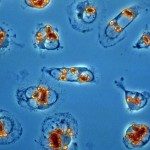Link to Pubmed [PMID] – 11853667
Cell 2002 Feb; 108(3): 317-29
How sister kinetochores attach to microtubules from opposite spindle poles during mitosis (bi-orientation) remains poorly understood. In yeast, the ortholog of the Aurora B-INCENP protein kinase complex (Ipl1-Sli15) may have a role in this crucial process, because it is necessary to prevent attachment of sister kinetochores to microtubules from the same spindle pole. We investigated IPL1 function in cells that cannot replicate their chromosomes but nevertheless duplicate their spindle pole bodies (SPBs). Kinetochores detach from old SPBs and reattach to old and new SPBs with equal frequency in IPL1+ cells, but remain attached to old SPBs in ipl1 mutants. This raises the possibility that Ipl1-Sli15 facilitates bi-orientation by promoting turnover of kinetochore-SPB connections until traction of sister kinetochores toward opposite spindle poles creates tension in the surrounding chromatin.


